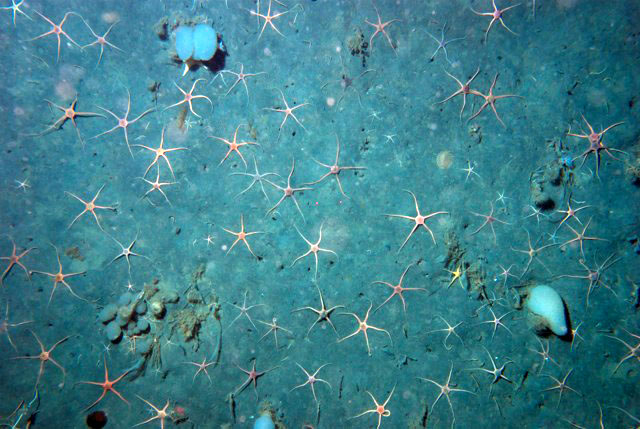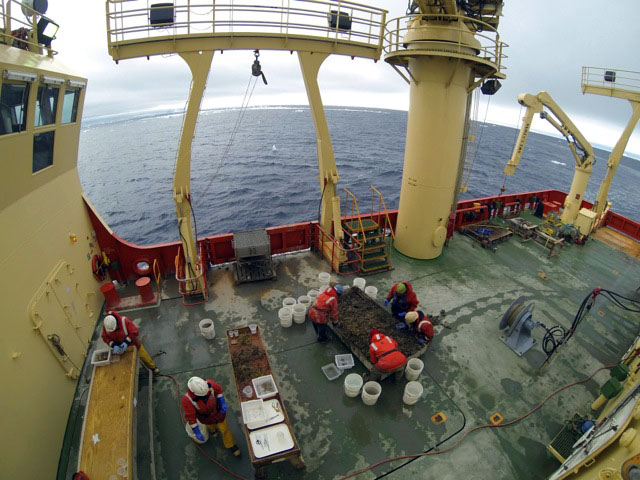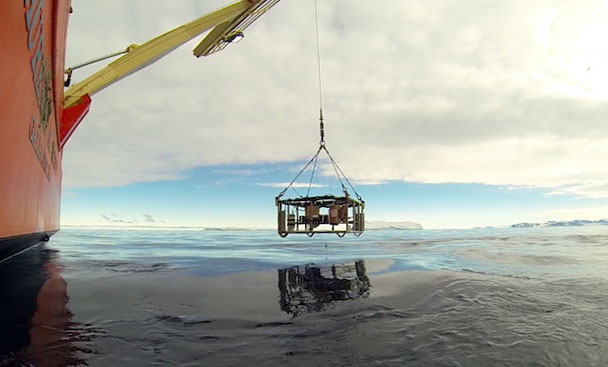Split the differenceResearchers investigate genetic connectivity of species around the AntarcticPosted September 11, 2014
Related Story A sea star is a sea star is a sea star. Right? The answer to that question is not particularly straightforward, particularly when attempting to address species diversity around the entire Antarctic continent. That’s exactly what a group of scientists – led by Kenneth Halanych The team, made up of experts on variety of benthic organisms, from sea stars and sea spiders to worms and crustaceans, is studying genetic connectivity among marine species to determine if, for example, a sea star found on the continental slope of the Antarctic Peninsula is the same as one lying on the seafloor of the Ross Sea. There are at least three reasons such distinctions are important, according to Halanych, principal investigator on the project. First, there is the need for basic understanding of the biodiversity around Antarctica, where information on many benthic species can be scarce. Second, confirming a genetic link between a species like Odontaster validus, Antarctica’s (apparently) ubiquitous sea star, across geographic distances helps ensure that studies examining a specimen at one location are applicable to other sites. Finally, there is the climate change component. As the oceans warm and grow more acidic, species distribution and community composition will change over time. “Biodiversity and our work establishing baseline levels of distribution of species in the benthic system in Antarctica is one of the most significant impacts of our work,” said Mahon, an assistant professor in the Biology Department at Central Michigan University. “With global climate change impacting the Southern Ocean, and with some species having a strong intolerance to minute temperature changes … we need to know this information now rather than waiting until it is too late and we lose it,” he added. Halanych led a similar project in the mid-2000s that investigated the genetic connectivity between species living several hundred meters deep on the continental shelves of South America and the Antarctic Peninsula. [See previous article In that case, distance mattered less than the physical ocean barriers of temperature and current. The Antarctic Polar Front, or the Antarctic Convergence, is where the colder, north-flowing waters from Antarctica meet the relatively warm waters of the subantarctic. The world’s largest ocean current, the Antarctic Circumpolar Current, encircles the continent. The former seems to serve as a barrier between the north-south flow of species – but not in all instances – such as with the ribbon worm Parborlasia corrugatus, which Halanych refers to as the “nastiest animal on the planet.” A scavenger that secretes an acidic mucus and can grow two meters long, genetically linked specimens of P. corrugatus were found around the Antarctic and subantarctic islands. However, the South American population was genetically distinct. The genetic split seems to have happened about five million years ago, Halanych noted, well after the Antarctic Polar Front and Circumpolar Current formed. Those studies, in part, led to the current project, which involved two research cruises, each about two months long, over the course of a calendar year. The January-February expedition 
Photo Credit: Auburn University
The red line shows the location of the GOULD during the second research cruise in 2013.
The second cruise in November-December “Unfortunately, we couldn’t go much south of Anvers Island,” Halanych said, where the U.S. Antarctic Program’s Palmer Station Still, both cruises proved fruitful in terms of the number and types of specimens collected, mostly by skimming the seafloor using an instrument called a Blake Trawl, a metal frame with a net on it that it is towed behind the ship. Results from the fieldwork are months if not years away, but the team did discover a number of new species during their long days trawling around the Southern Ocean. One particular find that excited Halanych – and resulted in a paper last year in Nature Communications – was the discovery of at least two undescribed species of acorn worms. Not only was their presence in the Antarctic a surprise, but they exhibited behavior, including the construction of short-lived tubes, that suggested a relationship to species in the fossil record that dates back a half-billion years ago. “This is a whole class of invertebrates that really wasn’t known in the Antarctic, and we found several of them,” Halanych said. Other new species included equally skin-crawling critters like leeches and parasites, including a copepod parasite that preferred worms as a host. “We also collected some of the bone worms [that feed on whale carcasses], which I had never seen before,” Mahon said. “Truly amazing. I always love collecting sea spiders, and the opportunity to collect leeches, particularly one that was nearly a foot long, was incredible.” Another instrument aboard the ship – a yo-yo camera – documented that diversity wasn’t limited just to the invertebrate marine species. The camera, secured in a waterproof and pressure-proof casing, sits in a stainless steel cage. A weight on a cable that dangles beneath the cage triggers the camera and flash when the weight contacts the seafloor. The cage slowly bounces up and down like a yo-yo as the ship moves, triggering another picture each time the weight contacts the seafloor. Pictures from the yo-yo camera revealed a variety of habitats exist around the continental shelf of Antarctica. “I think there is much more heterogeneity and different kinds of environment than people appreciate in the Antarctic,” Halanych said. “It’s not a single Antarctic marine environment. It’s many, many different marine environments.” NSF-funded research in this article: Kenneth Halanych and Scott Santos, Auburn University, Award No. 1043745 |



For USAP Participants |
For The Public |
For Researchers and EducatorsContact UsNational Science FoundationOffice of Polar Programs Geosciences Directorate 2415 Eisenhower Avenue, Suite W7100 Alexandria, VA 22314 Sign up for the NSF Office of Polar Programs newsletter and events. Feedback Form |






